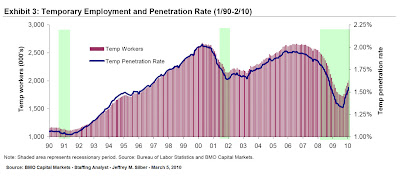By: Lee Vecchione
The United States lost 36,000 jobs in February, which came in better than consensus expectations for a decline of 75,000.The unemployment rate held steady at 9.7%.
While the United States is still losing jobs there is a positive signunderneath the surface.
The temp penetration rate, which measures the number of temporary workers as a % of the workforce, has continued to increase from a trough in September.In the early stages of a recovery, employers are prone to hire temp workers first and then convert them to full time status as confidence and visibility improves.
According to Jeffrey Silber, Staffing analyst at BMO Capital Markets, this has historically been highly correlated to changes in the S&P 500, with the bottom coinciding with the end of recessions.That is inline with economists dating the trough of this recession roughly around August. Keep in mind it takes 125,000 jobs created per month just to keep up with population growth and 200,000 per month over the next 2 years just to regroup the 5 million jobs lost since 2008.
Going forward the 2010 census program will hire 1.4 million workers through late summer, with as many as 700,000 jobs to be added in May alone.One interesting fact is that 1.4 million is more than double the amount of people hired to complete the last census in 2000.Perhaps the government is trying to jump start hiring by improving confidence in the private sector?
According to Bank of America – Merrill Lynch’s economics team, this could drive the unemployment rate to as low as 9.2% in the second quarter.These are temporary jobs and unless these workers can find employment after the census is complete, they will roll back off into the ranks of the unemployed.
There continues to be a divergence between the official U-3 rate and the unofficial U-6 rate, which accounts for people who have stopped looking for work or can’t find full-time jobs.The U-6 increased in February to 16.8%, only .6% below its peak of 17.4% in October.Until the U-3 and U-6 begin to converge, there is still a long road to improved confidence and sustainability in the economic recovery.
To keep things in perspective, CalculatedRisk posted this chart that clearly shows just how severe this recession has been compared to all post-WWII recessions.






